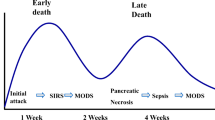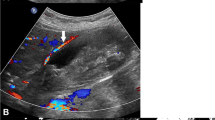Abstract
Background
Massive hemobilia is a rare but potentially life-threatening cause of upper gastrointestinal hemorrhage. In this retrospective analysis, we have evaluated the challenges involved in the diagnosis and management of massive hemobilia.
Methods
Between 2001 and 2011, a total of 20 consecutive patients (14 males) who were treated in our department for massive hemobilia were included in the study and their records were retrospectively analyzed.
Results
Causes of hemobilia were blunt liver trauma (n = 9), hepatobiliary intervention (n = 4), post-laparoscopic cholecystectomy hepatic artery pseudoaneurysm (n = 3), hepatobiliary tumors (n = 3), and vascular malformation (n = 1). Melena, abdominal pain, hematemesis, and jaundice were the leading symptoms. All patients had undergone upper GI endoscopy, abdominal ultrasound, and computerized tomography of the abdomen. An angiogram and therapeutic embolization were done in 12 patients and was successful in nine but failed in three, requiring surgery. Surgical procedures performed were right hepatectomy (n = 4), extended right hepatectomy (n = 1), segmentectomy (n = 1), extended cholecystectomy (n = 1), repair of the pseudoaneurysm (n = 3), and right hepatic artery ligation (n = 1).
Conclusion
The successful diagnosis of hemobilia depends on a high index of suspicion for patients with upper GI bleeding and biliary symptoms. Although transarterial embolization is the therapeutic option of choice for massive hemobilia, surgery has a definitive role in patients with hemodynamic instability, after failed embolization, and in patients requiring laparotomy for other reasons.






Similar content being viewed by others
References
Blumgart LH (2007) Hemobilia and bilhemia. In: Blumgart LH (ed) Surgery of the liver, biliary tract, and pancreas, 4th edn. Elsevier, Philadelphia, pp 1067–1081
Green MH, Duell RM, Johnson CD, Jamieson NV (2001) Hemobilia. Br J Surg 88:773786
Sandblom P (1948) Hemorrhage into the biliary tract following trauma: ‘traumatic hemobilia’. Surgery 24:571–586
Merrell SW, Schneider PD (1991) Hemobilia: evolution of current diagnosis and treatment. West J Med 155:621–625
Curet P, Baumer R, Roche A, Grellet J, Mercadier M (1984) Hepatic hemobilia of traumatic or iatrogenic origin: recent advances in diagnosis and therapy, review of the literature from 1976 to 1981. World J Surg 8:2–8. doi:10.1007/BF01658356
Yoshida J, Donahue PE, Nyhus LM (1987) Hemobilia: review of recent experience with a worldwide problem. Am J Gastroenterol 82:448–453
Levinson JD, Olsen G, Terman JW (1972) Hemobilia secondary to percutaneous liver biopsy. Arch Intern Med 130:396–400
Lee SP, Tasman-Jones C, Wattie WJ (1977) Traumatic hemobilia: a complication of percutaneous liver biopsy. Gastroenterology 72:941–944
Cahow CE, Burrell M, Greco R (1977) Hemobilia following percutaneous transhepatic cholangiography. Ann Surg 185:235–241
Monden M, Okamura J, Kobayashi N et al (1980) Hemobilia after percutaneous transhepatic biliary drainage. Arch Surg 115:161–164
Sarr MG, Kaufman SL, Zuidema GD, Cameron JL (1984) Management of hemobilia associated with transhepatic internal biliary drainage catheters. Surgery 95:603–607
Sandblom P, Mirkovitch V (1979) Minor hemobilia. Clinical significance and patho-physiological background. Ann Surg 190:254–264
Czemiak A, Thompson JN, Hemingway AP et al (1988) Hemobilia: a disease in evolution. Arch Surg 123:718–721
Blumenthal DS (1988) Ascariasis. In: Wyngaarden JB, Smith LH (eds) Cecil Textbook of Medicine, 18th edn. WB Saunders, Philadelphia, p 1908
Koshy A, Khuroo MS, Suri S, Datta DV, Khanna SK (1979) Amoebic liver abscess with hemobilia. Am J Surg 138:453–455
Wagner DS, Flynn MA (1985) Hemorrhagic acalculous cholecystitis causing acute pancreatitis after trauma. J Trauma 25:253–256
Adam R, Fabiani B, Bismuth H (1989) Hematobilia resulting from heterotopic stomach in the gallbladder neck. Surgery 105:564–569
Wright RC, Roberts JW (1988) Fibro lamellar carcinoma of the liver presenting with hemobilia. Contemp Surg 33:29–35
Hasan S, Quintana J, Siddiqui Y, Maldonado V (1986) Carcinoma of the pancreas presenting with hemobilia (Letter). Gastrointest Endosc 32:305–306
Laing FC, Frates MC, Feldstein VA, Goldstein RB, Mondro S (1997) Hemobilia: sonographic appearances in the gallbladder and biliary tree with emphasis on intracholecystic blood. J Ultrasound Med 16:537–543
Walter JF, Passo BT, Cannon WB (1976) Successful trans-catheter embolic control of massive hemobilia secondary to liver biopsy. AJR Am J Roentgenol 127:847–849
Greenberg M, Rubin JM, Crass JR (1983) The ultrasound appearance of an arteriobiliary fistula. J Clin Ultrasound 11:323–325
Grant EG, Smimiotopoulos JG (1983) Intraluminal gall bladder hematoma: sonographic evidence of hemobilia. J Clin Ultrasound 1:507–509
Poletti PA, Kinkel K, Vermeulen B et al (2003) Blunt abdominal trauma: should US be used to detect both free fluid and organ injuries? Radiology 227:95–103
Yoshii H, Sato M, Yamamoto S et al (1998) Usefulness and limitations of ultrasonography in the initial evaluation of blunt abdominal trauma. J Trauma 45:45–50 discussion 50–51
Kendall JL, Faragher J, Hewitt GJ, Burcham G, Haukoos JS (2009) Emergency department ultrasound is not a sensitive detector of solid organ injury. West J Emerg Med 10:1–5
Richards JR, McGahan JP, Pail MJ et al (1999) Sonographic detection of blunt hepatic trauma: hemoperitoneum and parenchymal injury patterns of injury. J Trauma 47:1092–1097
Yoon W, Jeong YY, Kim JK, Seo JJ, Lim HS, Shin SS et al (2005) CT in blunt liver trauma. Radiographics 25:87–104
Sharipo MJ (1994) The role of the radiologist in the management of gastrointestinal bleeding. Gastroenterol Clin North Am 23:123–131
Lee SM, Lee RGL, Clouse ME, Hill TC (1986) Demonstration of hemobilia using technetium-99m labeled red blood cells. Clin Nucl Med 11:52
Hsu KL, Ko SF, Chou FF, Sheen-Chen SM, Lee TY (2002) Massive hemobilia. Hepatogastroenterology 40:306–310
Franklin RH, Bloom WF, Schoffstall RO (1980) Angiographic embolization as the definitive treatment of post-traumatic hemobilia. J Trauma 20:702–705
Wagner WH, Lundell CJ, Donovan AJ (1985) Percutaneous angiographic embolization for hepatic arterial hemorrhage. Arch Surg 120:1241–1249
Moodley J, Sing B, Lallo S, Pershad S, Robbs JV (2001) Non-operative management of hemobilia. Br J Surg 88:1073–1076
Forlee MV, Krige JE, Welman CJ, Beningfield SJ (2004) Hemobilia after penetrating and blunt liver injury: treatment with selective hepatic artery embolization. Injury 35:23–28
Sandblom P, Saegesser F, Mirovitch V (1984) Hepatic hemobilia: hemorrhage from the intrahepatic biliary tract, a review. World J Surg 8:41–50. doi:10.1007/BF01658362
Dousset B, Sauvanet A, Barddou M, Legman P, Vilgrain V, Belghiti J (1997) Selective surgical indications for iatrogenic hemobilia. Surgery 121:37–41
Kaman L, Kumar S, Behera A, Katariya RN (1998) Pseudoaneurysm of the cystic artery: a rare cause of hemobilia. Am J Gastroenterol 93:1535–1537
Lee SL, Caruso DM (1999) Acute cholecystitis secondary to hemobilia. J Laparoendosc Adv Surg Tech A 9:347–349
Hubens A, De Schepper A (1979) Hepatic artery aneurysm: a pitfall in biliary surgery. Br J Surg 66:259–261
Conflict of interest
No benefits in any form have been received or will be received from a commercial party related directly or indirectly to the subject of this article.
Author information
Authors and Affiliations
Corresponding author
Rights and permissions
About this article
Cite this article
Devakumar Murugesan, S., Sathyanesan, J., Lakshmanan, A. et al. Massive Hemobilia: A Diagnostic and Therapeutic Challenge. World J Surg 38, 1755–1762 (2014). https://doi.org/10.1007/s00268-013-2435-5
Published:
Issue Date:
DOI: https://doi.org/10.1007/s00268-013-2435-5




